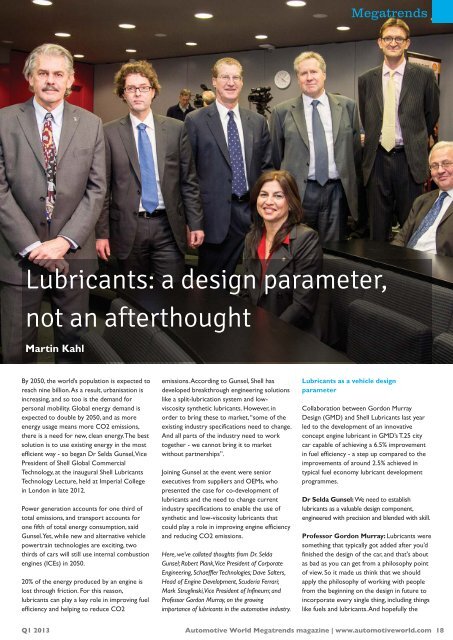megatrends
megatrends
megatrends
Create successful ePaper yourself
Turn your PDF publications into a flip-book with our unique Google optimized e-Paper software.
Lubricants: a design parameter,<br />
not an afterthought<br />
Martin Kahl<br />
By 2050, the world’s population is expected to<br />
reach nine billion. As a result, urbanisation is<br />
increasing, and so too is the demand for<br />
personal mobility. Global energy demand is<br />
expected to double by 2050, and as more<br />
energy usage means more CO2 emissions,<br />
there is a need for new, clean energy. The best<br />
solution is to use existing energy in the most<br />
efficient way - so began Dr Selda Gunsel, Vice<br />
President of Shell Global Commercial<br />
Technology, at the inaugural Shell Lubricants<br />
Technology Lecture, held at Imperial College<br />
in London in late 2012.<br />
Power generation accounts for one third of<br />
total emissions, and transport accounts for<br />
one fifth of total energy consumption, said<br />
Gunsel. Yet, while new and alternative vehicle<br />
powertrain technologies are exciting, two<br />
thirds of cars will still use internal combustion<br />
engines (ICEs) in 2050.<br />
20% of the energy produced by an engine is<br />
lost through friction. For this reason,<br />
lubricants can play a key role in improving fuel<br />
efficiency and helping to reduce CO2<br />
Q1 2013<br />
emissions. According to Gunsel, Shell has<br />
developed breakthrough engineering solutions<br />
like a split-lubrication system and lowviscosity<br />
synthetic lubricants. However, in<br />
order to bring these to market, “some of the<br />
existing industry specifications need to change.<br />
And all parts of the industry need to work<br />
together - we cannot bring it to market<br />
without partnerships”.<br />
Joining Gunsel at the event were senior<br />
executives from suppliers and OEMs, who<br />
presented the case for co-development of<br />
lubricants and the need to change current<br />
industry specifications to enable the use of<br />
synthetic and low-viscosity lubricants that<br />
could play a role in improving engine efficiency<br />
and reducing CO2 emissions.<br />
Here, we’ve collated thoughts from Dr. Selda<br />
Gunsel; Robert Plank, Vice President of Corporate<br />
Engineering, Schaeffler Technologies; Dave Salters,<br />
Head of Engine Development, Scuderia Ferrari;<br />
Mark Struglinski, Vice President of Infineum; and<br />
Professor Gordon Murray, on the growing<br />
importance of lubricants in the automotive industry.<br />
Megatrends<br />
Lubricants as a vehicle design<br />
parameter<br />
Collaboration between Gordon Murray<br />
Design (GMD) and Shell Lubricants last year<br />
led to the development of an innovative<br />
concept engine lubricant in GMD’s T.25 city<br />
car capable of achieving a 6.5% improvement<br />
in fuel efficiency - a step up compared to the<br />
improvements of around 2.5% achieved in<br />
typical fuel economy lubricant development<br />
programmes.<br />
Dr Selda Gunsel: We need to establish<br />
lubricants as a valuable design component,<br />
engineered with precision and blended with skill.<br />
Professor Gordon Murray: Lubricants were<br />
something that typically got added after you’d<br />
finished the design of the car, and that's about<br />
as bad as you can get from a philosophy point<br />
of view. So it made us think that we should<br />
apply the philosophy of working with people<br />
from the beginning on the design in future to<br />
incorporate every single thing, including things<br />
like fuels and lubricants. And hopefully the<br />
Automotive World Megatrends magazine | www.automotiveworld.com 18


